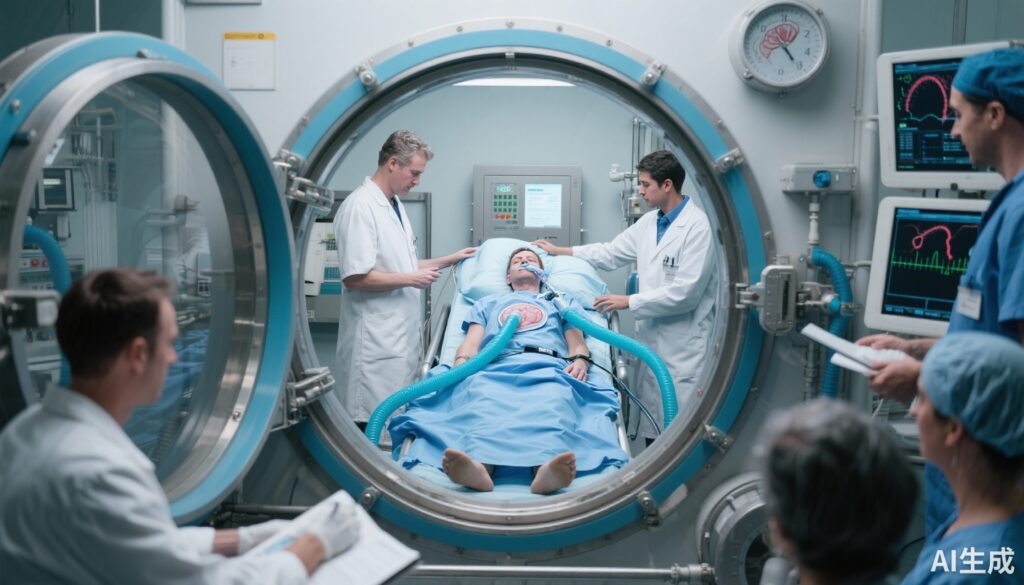Highlight
– Hyperbaric oxygen therapy (HBOT) combined with standard postoperative care improves treatment effectiveness by 19% in patients after intracranial aneurysm surgery.
– HBOT significantly enhances neurologic recovery, activities of daily living, self-care ability, and quality of life compared to standard care alone.
– Consistent effects observed across 11 randomized controlled trials with minimal heterogeneity support HBOT’s potential for integration into perioperative protocols.
Study Background and Disease Burden
Intracranial aneurysms, abnormal bulges in cerebrovascular walls, pose a significant risk of subarachnoid hemorrhage, leading to substantial morbidity and mortality worldwide. Surgical interventions such as microsurgical clipping and endovascular coiling aim to prevent aneurysm rupture but often carry risks of postoperative neurologic deficits and compromised functional status. Recovery from such neurosurgical procedures can be protracted, with many patients experiencing impairments in neurologic function and activities of daily living (ADL), resulting in diminished quality of life (QoL).
Hyperbaric oxygen therapy (HBOT) involves inhalation of 100% oxygen at pressures exceeding atmospheric levels, enhancing oxygen delivery to ischemic brain tissues. Although HBOT is established for select neurologic indications, its role in augmenting recovery after cerebral aneurysm surgery remains understudied. The recent systematic review and meta-analysis by Gao et al. (2025) addresses a critical unmet need by rigorously evaluating HBOT’s efficacy as an adjunctive treatment in the postoperative management of intracranial aneurysm patients.
Study Design
The investigators conducted a systematic review and meta-analysis including 11 randomized controlled trials (RCTs) conducted in China, published between 2007 and 2025. The total sample comprised over 2000 adult patients who underwent surgical treatment for intracranial aneurysms via microsurgical clipping or endovascular coiling.
Participants were evenly randomized to receive either HBOT plus standard postoperative care or standard care alone (which in some studies included sham therapy without oxygen administration). The protocol for HBOT consisted of administering 100% oxygen at pressures exceeding 1.4 atmosphere absolute (ATA).
Primary endpoints evaluated included:
– Overall treatment effectiveness,
– Neurologic function (evaluated by standardized scales),
– Activities of daily living (ADL),
– Self-care ability as measured by the Barthel Index,
– Health-related quality of life assessed by the 36-item Short Form Survey (SF-36).
Key Findings
The meta-analysis revealed robust benefits of HBOT in postoperative patients after intracranial aneurysm repair:
1. Treatment Effectiveness: The HBOT group demonstrated a 19% improvement in treatment response rate relative to controls, with a combined risk ratio of 1.19 (P < .00001). This suggests a significantly higher odds of favorable clinical outcomes when HBOT is integrated.
2. Neurologic Function: Compared to controls, patients receiving HBOT showed a pooled standardized mean difference (SMD) of -0.6 (P < .00001) in neurologic function scores, indicating meaningful recovery and reduced neurologic deficits.
3. Functional Independence and Self-care: Incorporation of HBOT led to substantially improved ADL scores (pooled SMD 1.2; P < .00001) and Barthel Index scores (pooled SMD 1.0; P < .00001), reflecting better independence in daily activities and self-care abilities.
4. Quality of Life: Health-related quality-of-life outcomes were markedly enhanced in the HBOT group, with a pooled SMD of 1.3 (P < .00001), underscoring improvements in both physical and mental health components.
Importantly, the findings were consistent across all eleven RCTs analyzed, exhibiting minimal heterogeneity. This consistency strengthens the reliability of the results and supports the reproducibility of clinical benefits of HBOT.
Expert Commentary
The comprehensive data synthesis by Gao et al. provides compelling evidence supporting HBOT as an adjunctive therapeutic modality after intracranial aneurysm surgery. The observed improvements in neurologic function and functional independence align with the biological rationale that hyperoxygenation promotes neuronal repair, reduces ischemic injury, and mitigates perioperative brain edema.
Despite these promising results, experts caution that the included RCTs were all conducted in a single country, and variations in surgical techniques, rehabilitation infrastructure, and HBOT protocols could affect generalizability. Some studies lacked blinding or had relatively short follow-ups, which may introduce bias or limit assessment of long-term outcomes.
Moreover, safety profiles, although not extensively detailed in the meta-analysis, merit consideration given possible HBOT complications such as barotrauma or oxygen toxicity. Future international trials with standardized protocols and extended follow-ups are essential to confirm efficacy, safety, and cost-effectiveness.
Current neurosurgical and neurorehabilitation guidelines do not yet include HBOT routinely, but these findings may prompt reconsideration, especially for patients at high risk of postoperative neurologic deficits.
Conclusion
This meta-analysis robustly demonstrates that adding hyperbaric oxygen therapy to standard postoperative care significantly enhances clinical outcomes in patients undergoing surgical treatment of intracranial aneurysms. Specifically, HBOT confers improved neurologic recovery, greater functional independence, and better quality of life. The consistency and magnitude of these effects justify integrating HBOT into perioperative care protocols while awaiting further confirmatory research.
Clinicians should weigh current evidence alongside individual patient factors, logistical feasibility, and safety considerations. Incorporating HBOT holds promise as a transformative strategy to optimize recovery trajectories after complex cerebrovascular surgery, ultimately reducing disability burden and improving patient-centered outcomes.
References
1. Gao Y, Sun X, Wang G. Efficacy of hyperbaric oxygen therapy in postoperative patients with cerebral aneurysms: a systematic review and meta-analysis. Front Neurol. 2025;16:1645028. doi:10.3389/fneur.2025.1645028
2. Starke RM, Chalouhi N, Ding D, et al. Cerebral aneurysms: evolving treatment and management. Neurosurg Focus. 2014;37(3):E5. doi:10.3171/2014.6.FOCUS14180
3. Thom SR. Hyperbaric oxygen: its mechanisms and efficacy. Plast Reconstr Surg. 2011;127 Suppl 1:131S-141S. doi:10.1097/PRS.0b013e3181fbe2bf
4. Ryvlin P, Sills GJ, O’Brien TJ. High pressure oxygen and hyperbaric therapy in epilepsy. Epilepsy Behav. 2020;109:107146. doi:10.1016/j.yebeh.2020.107146


